Art Criticism
A Neo-Rococo Movement Is On the Rise—But What Does It All Mean?
This sumptuous style, which is being revived by a growing cohort of artists, is like a cornucopia for complex meanings.
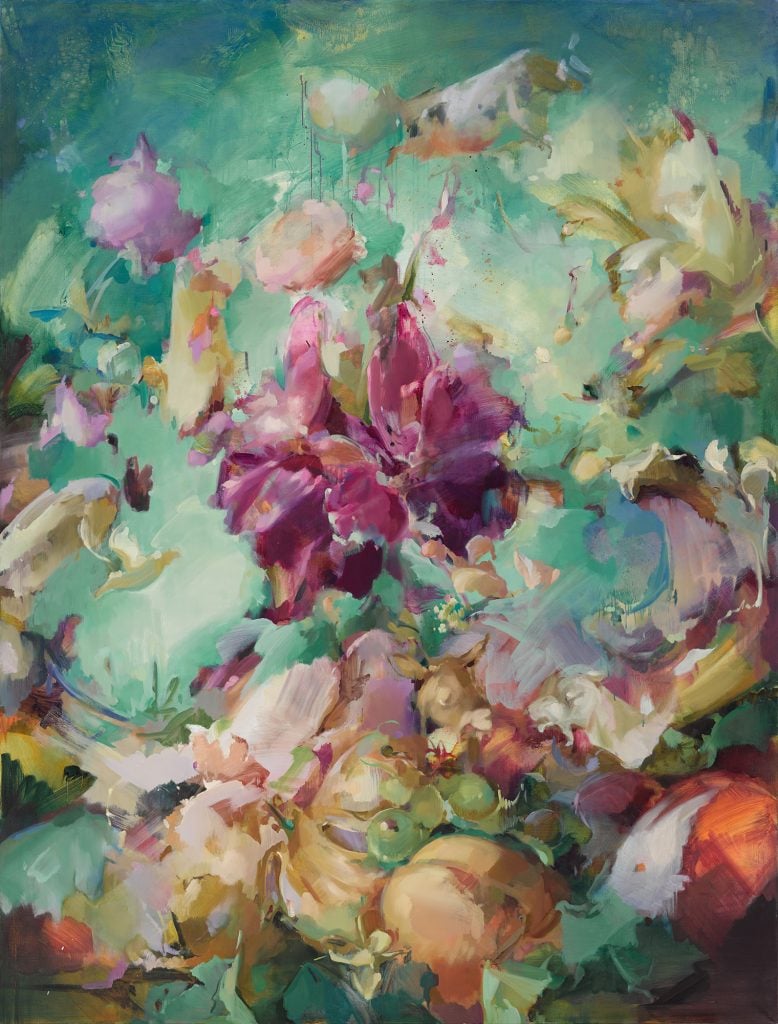
When facing the guillotine In December of 1793, Madame du Barry, the last mistress of King Louis XV, infamously made her final request, “Please, Mr. Executioner, just a little moment more!”
Du Barry, who was born Jeanne Bécu, the illegitimate daughter of a seamstress who, as a courtesan, rose to the highest ranks of the French court, seemed to encapsulate, in those words, the fleeting pleasures of the Rococo age: Facing death just two months after her courtly rival Marie Antoinette’s grisly demise, du Barry seemed only to want the party to last a bit longer.
And the Rococo had been quite the party. Almost three centuries later, the luscious trappings of the era—sinuous ornaments, pale pinks, courtly paramours, and primroses—still captivate the cultural imagination. Last year, in 2023, Jeanne du Barry, a film about this infamous mistress, was somewhat controversially released in France, starring director and actor Maïwenn in the titular role, and Johnny Depp starring as Louis XV. At Sotheby’s, auctions of Marie Antoinette’s furniture in 2023 and her jewels in 2018 shattered presale estimates. Not to mention, the decapitated queen had a scandalizing cameo at the Olympic opening ceremonies just a few weeks back.
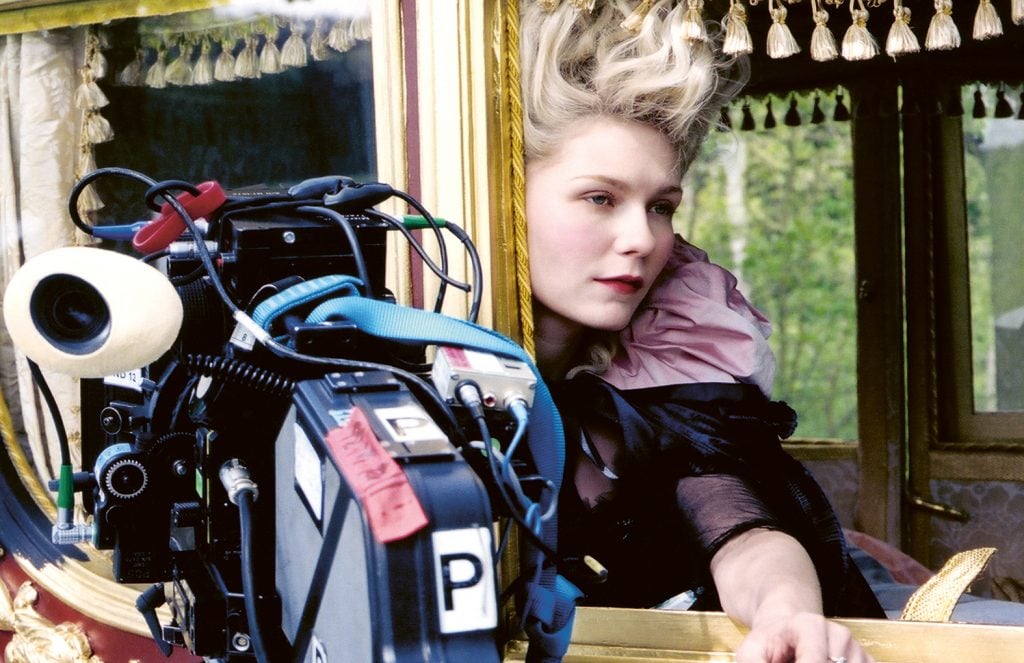
Kirsten Dunst on the set of Marie Antoinette (2006), from Sofia Coppola Archive (MACK, 2023). Photo: Courtesy of Andrew Durham and MACK.
This Neo-Rococo rise has been simmering in the cultural ether for some time now. A touchstone is filmmaker Sofia Coppola’s now cult-classic 2006 movie Marie Antoinette. The film featured sequences of aristocratic frivolity and boredom set to a Y2K indie rock soundtrack, capturing the checked-out ennui and the zeitgeist of the 1790s and the mid-aughts. Post-2001, Coppola’s gauzy Rococo dream, with wealthy youths consumed by intrigue and escapist pleasure as revolution and unprecedented change drummed in the distance, struck a chord with the millennial generation.
In the decades since, the world has become only more politically polarized, and the gap between the uber-wealthy and the common person more extreme. It is no small wonder then that, as an aesthetic in art, a Neo-Rococo is blossoming. It has been adopted by a cohort of artists, including Flora Yukhnovich, Michaela Yearwood-Dan, and Francesca DiMatteo, with collectors clamoring to buy up their sumptuous works in recent years. In 2022, writer Danielle Thom noticed a revival of Rococo aesthetics in contemporary art among women and queer artists. Since then, this embrace of aesthetics associated with aristocratic living has only deepened—but this generation of artists is tapping into the style in new and surprising ways.
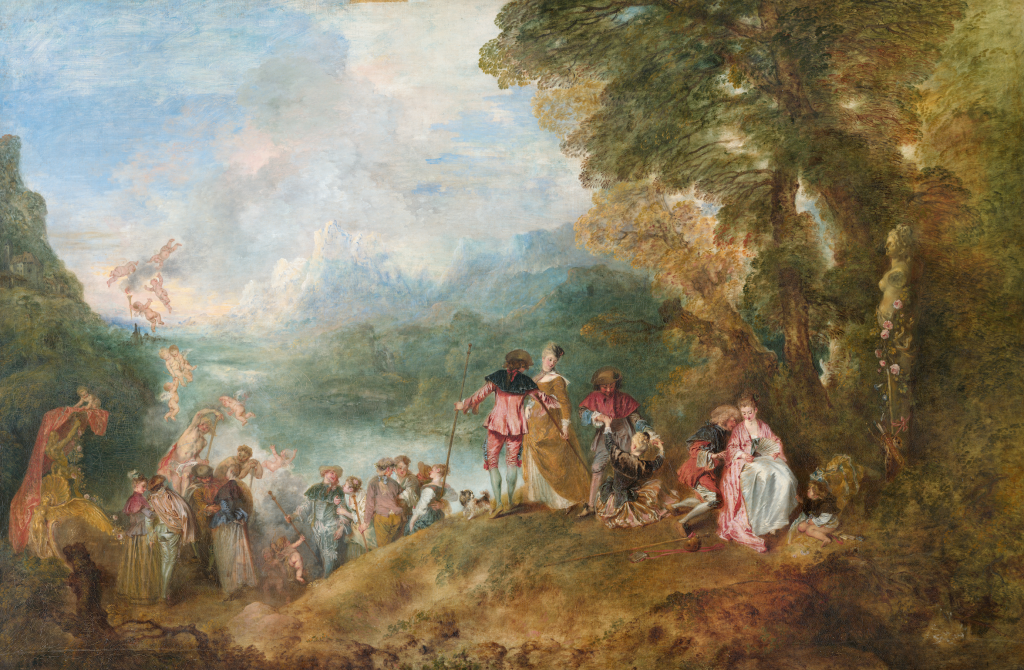
Jean-Antoine Watteau, The Embarkation for Cythera (1717). Collection of the Louvre, Paris.
What’s the Rococo About, Really?
The Rococo has traditionally been understood as the final manifestation of the Baroque era from which it emerged. The undulating lines and high drama of the Baroque, so closely associated with Catholic religious art, gave way to a pleasurable, secular vision of the world, one that was all about the here and now. Rococo, which spanned most of the 18th century following the death of Louis XIV in 1715, embraced more intimate scale. Whimsical ornamentation, asymmetry, soft pastel hues, and a sense of epicurean delight ascended above the geometry, dynamism, morality, and theater of the Baroque.
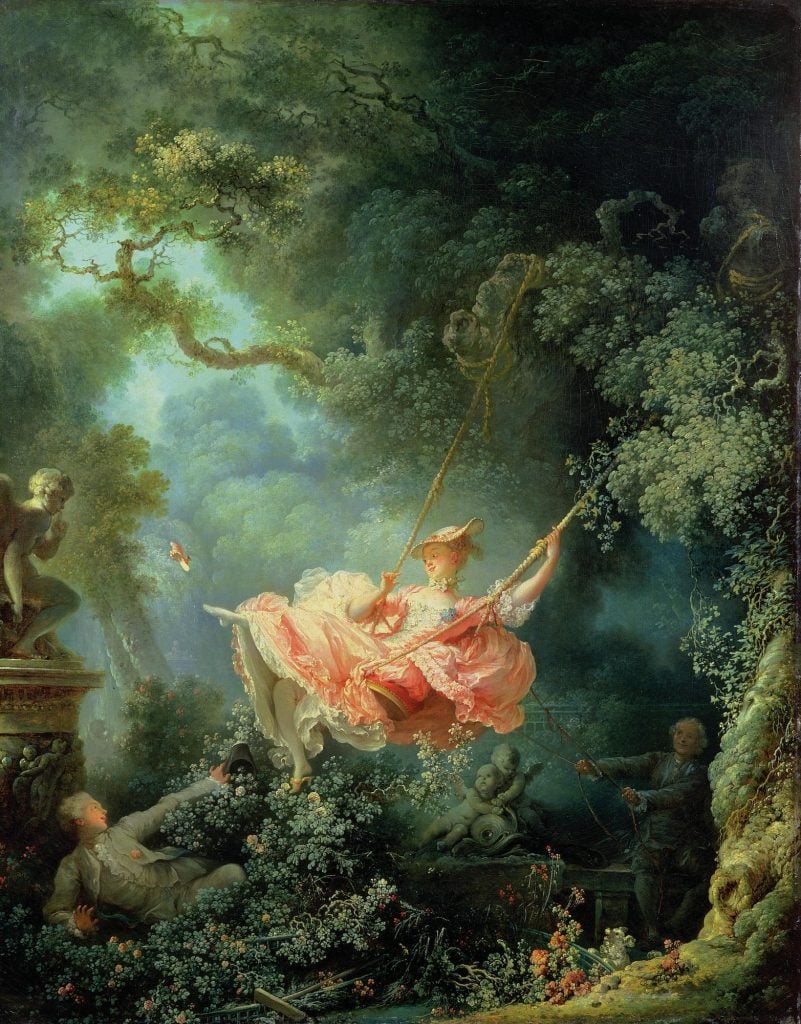
Jean-Honoré Fragonard, The Swing (ca. 1767). Courtesy of the Wallace Collection, London, United Kingdom.
As a multi-disciplinary movement originating in the decorative arts, Rococo expanded to encompass painting, sculpture, architecture, music, and even literature. In the visual arts, Jean-Antoine Watteau originated the style, pioneering the movement’s favorite subject matter, the fête galante, romantic courtship scenes in bucolic settings. Jean Honoré Fragonard and Francois Boucher later gave it their own spins, celebrating frivolity, pleasure, whimsy, wealth, romance, fashion, escapism, and fantasy, above all else. But by the late 1700s, the style fell out of vogue as the excavation of Pompeii spurred a Neoclassical revival.
Since its demise, the Rococo has oft-been derided by historians and critics as a less serious era of art-making, a mere confection of visual sugars, without much substance. But the Rococo has also been tied up in complicated ideas of femininity and meaning—which is why many contemporary artists are taking up the mantle.
Abstracted Femininity and Unapologetic Beauty
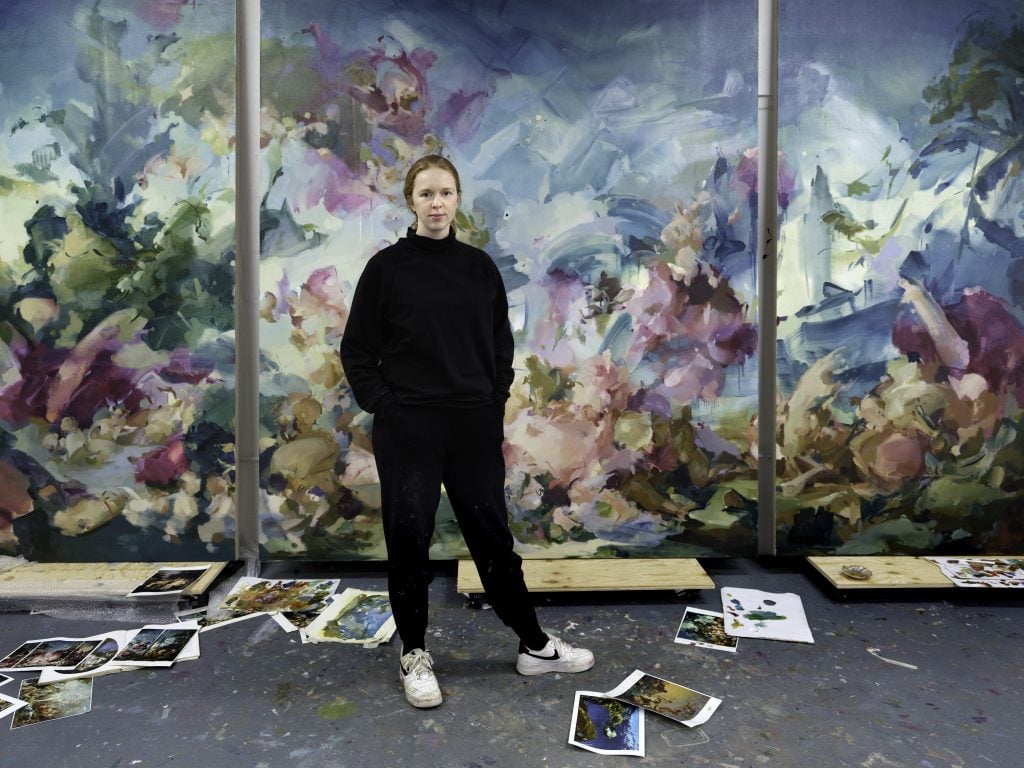
A current show at the Wallace Collection in London is an inflection point for these conversations across time. “Flora Yukhnovich and François Boucher: The Language of the Rococo” places new work by Yukhnovich, the most famous of these Neo-Rococo artists, in conversation with two paintings by the lauded French painter François Boucher, Pastoral with a Bagpipe Player (1749) and Pastoral with a Couple near a Fountain (1749).
Collectors and curators have been enraptured by the work of Yukhnovich, much like the Rococo artists of the past, even as it has faced ambivalence from critics. Nevertheless, the artist, who was born in 1990, remains supported by the art market: In 2022, her 2017 painting, Tu vas me faire rougir (You’re going to make me blush), an abstract reworking of Fragonard’s The Swing in fleshy pinks and vibrant greens, sold for just over $2.5 million at Christie’s London.
For all the rule-bending of the Rococo movement, the era’s paintings remained firmly rooted in figuration. In the flirtatious masterpiece The Swing, for instance, analysis of the painting typically centers on the triangulation of gestures between the woman on the swing, her lover shrouded in the bushes, and her unwitting companion. What happens when those figures disappear? How do we make sense of what’s left?
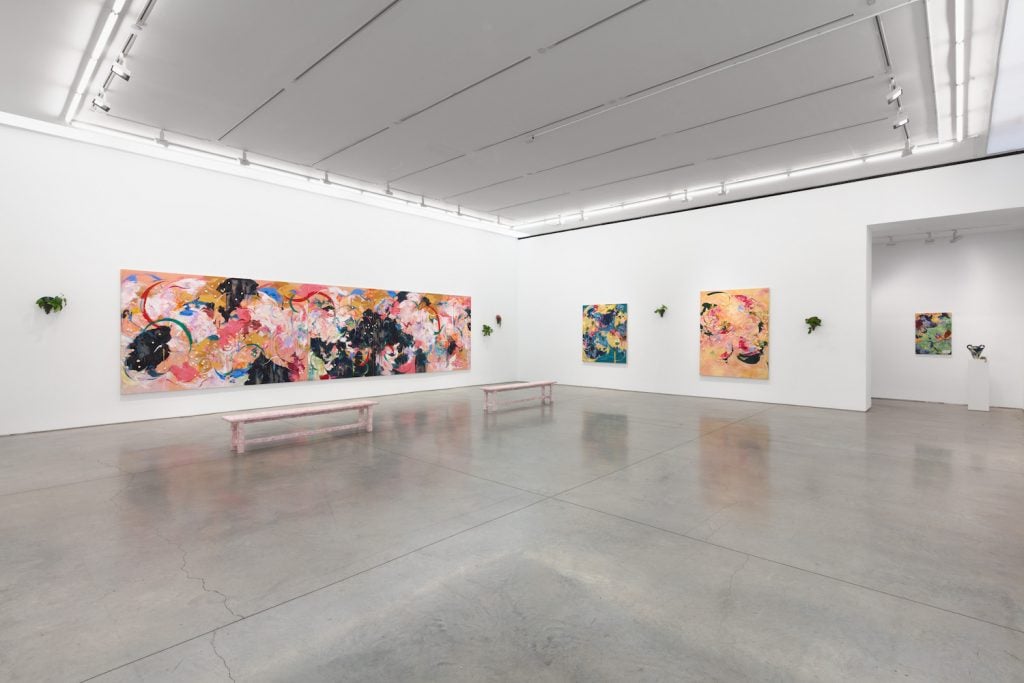
Installation view of “Michaela Yearwood-Dan: Some Future Will Think of Us” at Marianne Boesky Gallery. Photo by Lance Brewer. Image courtesy Marianne Boesky Gallery
Both Yukonovich and Michaela Yearwood-Dan have done just that—removed concrete figuration from their rapturous floral compositions. While their language hints at the Rococo world, their visions are abstracted, even eschewing an orienting horizon-line at times.
In some sense, removing figuration distills the Rococo style to its core: In the 18th century, the Rococo emerged first in the realm of the decorative arts. In other words, florals and ornamental forms were the backbone of the style. Without the narrative figurative elements that emerged between, these contemporary visions root themselves deeper as sublime visual pleasures, and momentary escape from the troubles of the world.
Interestingly, however, some contemporary artists see the language of the Rococo as a way of accessing a new audience—of women and feminine-identifying people—rather than as a delight for the ultra-wealthy as the Rococo had originally been. In their hands, the indulgent beauty of the Rococo becomes an unabashed celebration of the feminine, where the senses, rather than intellect, are prized.
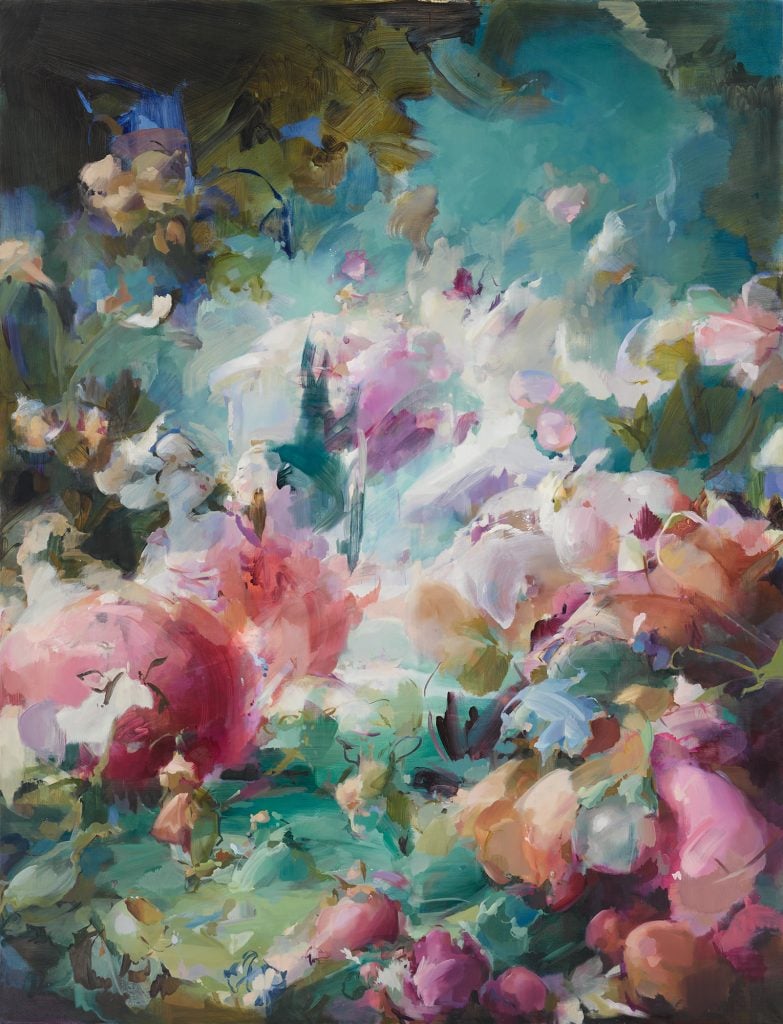
Flora Yukhnovich, Folies Bergère (2024) © Flora Yukhnovich. Courtesy the Artist and Victoria-Miro.
A Bad Word?
Yearwood-Dan said in a recent conversation that she was at first surprised by the labeling of her work as Rococo, seeing her work as rooted in landscape and modern abstraction. Lately, she’s more willing to embrace the Rococo label, however.
“When I look at Rococo work, I think, ‘Fine, if you wanna sit me in that category, it feels very complimentary—there are beautiful works,'” she said. “I see the connection to my work in the palettes of blues and the pinks and the greens and the way paint is handled on the canvas.” She, too, sees links to Yukonovich’s work and that of fellow U.K. artist Francesca Mollett, whose abstract paintings often juxtapose subtle variations on pastel hues. Other artists working in this style include artist Marijke Vasey, whose “frame paintings” loosely reference both the mirrors popular in the Rococo era and the frames of the artworks themselves.
But Yearwood-Dan also wonders about the tendency to dismiss Rococo aesthetics as frivolous. “Women-centered and feminine-centered movements are always chosen to be the less serious genres or styles,” she said. “I’m very intrigued to know if it’s a way to take away the significance of the work that these young contemporary artists, who happen to be female, are doing,”
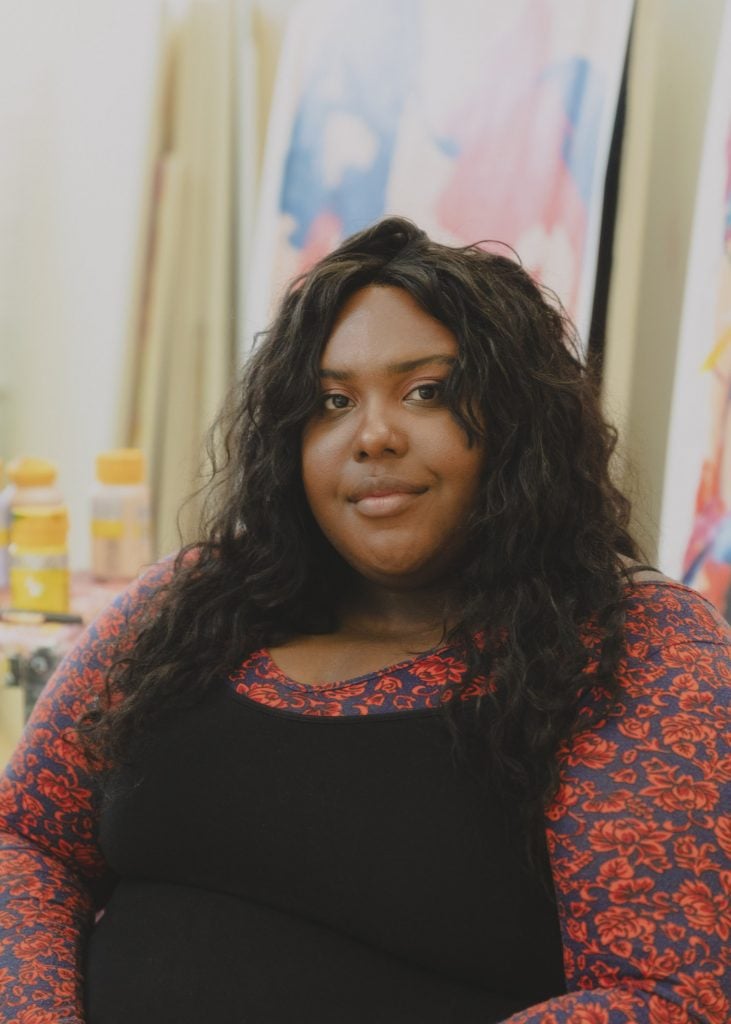
Michaela Yearwood-Dan. Photo by Sam Hylton. Image courtesy Michaela Yearwood-Dan.
Ultimately, femininity is something many of these Neo-Rococo artists are embracing—through abstraction or other forms. Yukhnovich has acknowledged, too, that she felt a kinship to that very femininity of Rococo painting. Back in a 2020 interview with Laura Franchetti, Yearwood-Dan explained her formal trajectory in the Courtauld’s post-graduate journal, Immediations. Initially, she had been researching the human figure as it appeared in the works of Lucian Freud and Frank Auerbach (“all very male artists,” she noted). When she turned towards decorative design, however, she realized that she was gravitating toward elements related to femininity and derived from the 18th-century movement.
“The aesthetic of the Rococo feels very familiar to me, and there are lots of things that I, as a woman and also as a girl growing up, interacted with which seem to have a Rococo sensibility to them,” she said. “I do not feel like that about many other art historical movements.” The “historical idea of femininity” that she drew from looking at Rococo contrasted contemporary ideas of femininity and “all of the things that are so often thrown at women today.”
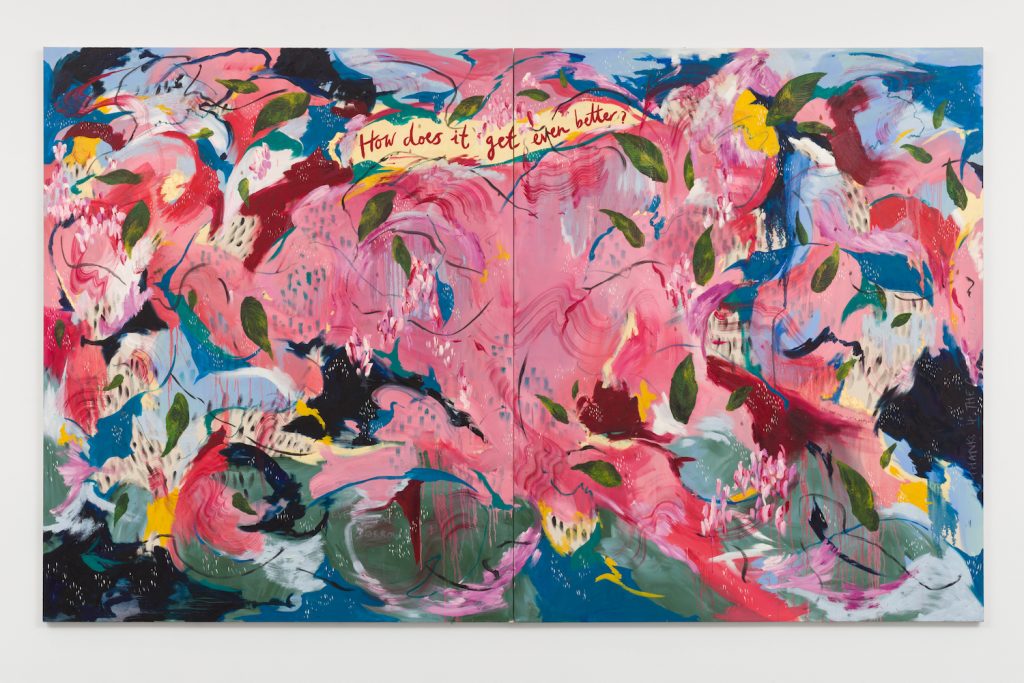
Michaela Yearwood-Dan, A conduit for joy, (2021). ©Michaela Yearwood-Dan. Image courtesy Marianne Boesky Gallery.
Yearwood-Dan, for one, doesn’t mind providing a space for visual escape, and the light-hearted playfulness did not deter her; she thinks it can welcome new people into the conversation. “Sometimes there is a sense of enjoyment from a painting that is so pure and so childlike,” she said. “Yet we get older and move deeper into the rules and norms of society. We don’t think that we can just enjoy something. We feel the need to interrogate why something feels good to us. If people don’t have a certain education or access to language, their opinion isn’t as valued as the opinion of someone who can over-intellectualize and make big conceptual statements. When it comes down to it, it might just be: I love those colors.”
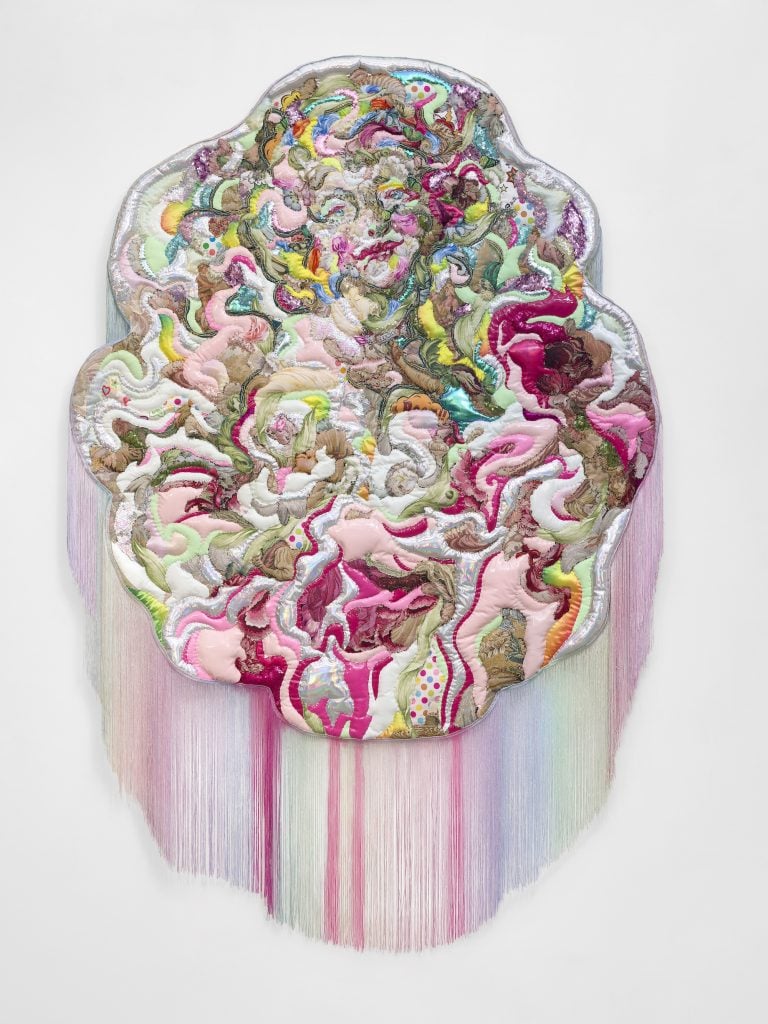
Anne von Freyburg, SUN KISSED (AFTER FRAGONARD, VENUS WITH DOVES) (2023). Courtesy of the artist.
The New Conchophilia
Looking across the Rococo era, one finds, curiously, a preponderance of imagery of shells, pearls, and stones, a motif that delighted tastes for the idiosyncratic, the asymmetrical, and the unique. This interest in shells is embedded in the word Rococo itself; Rococo derives from rocaille, the French word for the shells and pebbles used in shell grottoes popular in the 17th and 18th centuries.
But seashells also hint at eroticism. A longstanding symbol of the goddess Venus, shells signaled fertility. It’s perhaps unsurprising, then, to notice the predominance of shell imagery in the work of artists exploring Rococo aesthetics today.
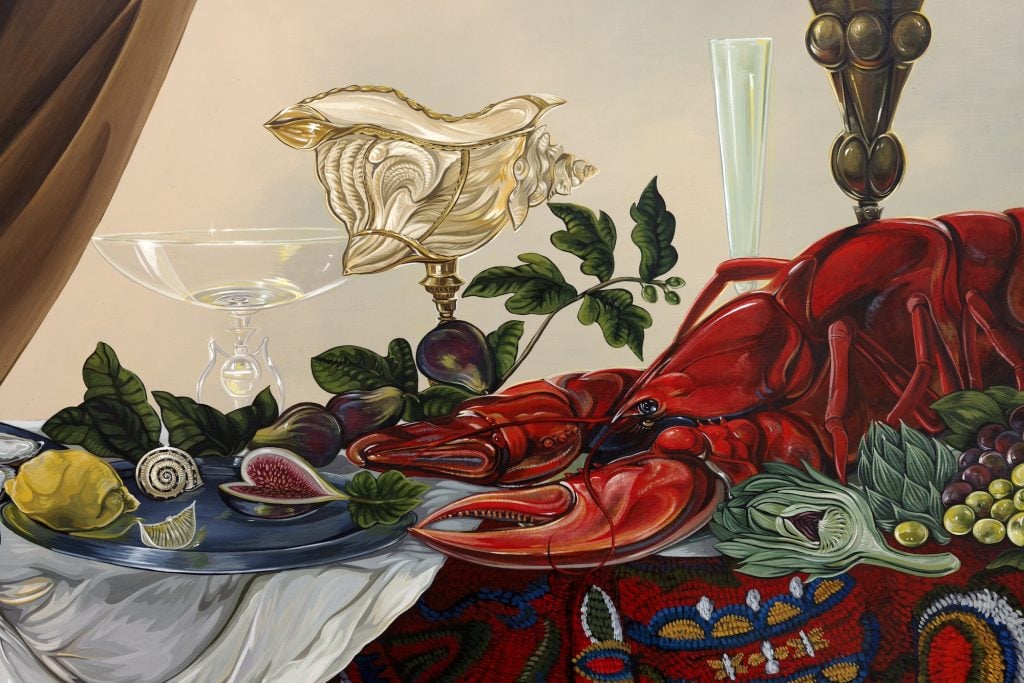
Detail of Sabrina Bockler’s Hungry Hearts (2024). Courtesy of the artist and Hashimoto Contemporary.
In her recent exhibition “Coquette” at Hashimoto Contemporary in New York, artist Sabrina Bockler mined this intersection between seashells and intimacy. One painting, The Alchemist, shows a woman adorned in a frilly pink dress, typical of the 18th century. Partially baring her body, she is busy making a love potion. Among the accouterments at her disposal is a small collection of shells signifying lust; the painting is an oblique allusion to Madame de Montespan, the mistress of Louis XIV, who was accused of controlling the King via poisons.
“I’m interested in female narratives and how women have been portrayed and ideas of femininity with the caveat of how they’ve been vilified,” Bockler explained. “In my research, I’ve found shells to be a very sexual reference,” she added, “Oysters, for instance, are a reference to a woman’s anatomy,” For Bockler, and other artists, like Ariana Papademetropoulos and Fawn Rogers, shells, with their unusual, mesmerizing shapes and surfaces, are another way of underscoring the physical world—and hint at it as traditional Rococo art did, via natural mounds of fleshy pink paint or the undulating bodily curves of the furniture.
But shells play another role in this Neo-Rococo world, too. Polish artist Monika Marchewka has earned a large social media following, with her dreamy scenes of mermaids, women, and seashells in Rococo hues. These mythical shells seem to be a sanctuary for daydreaming and femininity, far from the voices of criticism. “I hope these paintings are a place for relief. When you’re alone again, floating off on a shell,” Marchewka said, “maybe they’re a place you can cry.”
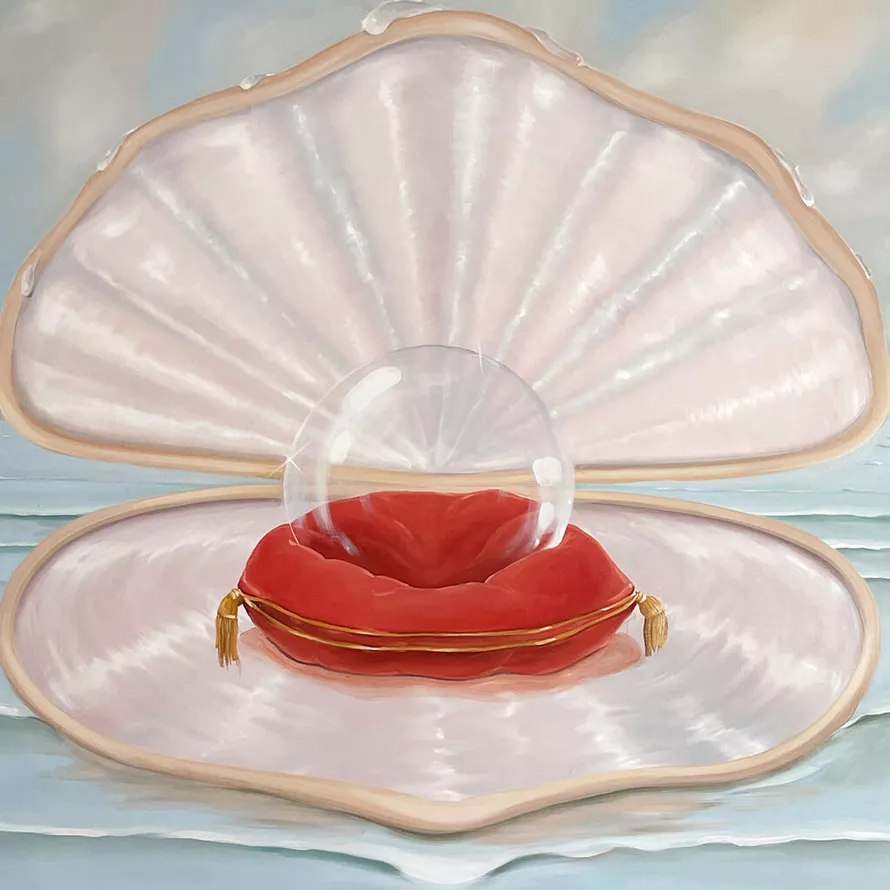
Monika Marchewka, False Promise (2023). Courtesy of the artist and Artistellar.
Embodied Pleasures, Asymmetrical Delights
Given the Rococo’s entwined history with the decorative arts, it is fitting that several Neo-Rococo artists are working beyond painting and embracing a sense of materiality that hints at more complex truths.
London-based Dutch artist Anne von Freyburg makes textile works that walk a fine line between celebrating the language of femininity and craft and acknowledging the perils of overindulgence. Appropriating and reimagining portraits by artists including Boucher and Fragonard, von Freyburg, who has a background in fashion design, translates acrylic ink drawings into hand-stitched textiles, which she then stuffs to create a bodily dimensionality. She sees these works as bridging the “craft” of sewing with the high art of painting, and reclaiming Rococo aesthetics, an era when “many of the patrons were aristocratic women.”
Von Freyburg’s textile portraits can be disorienting, exaggerated visions that can seem to be melting, edging toward the grotesque. That distortion is intentional and reflects what the artist sees as the unfortunate parallels between the 18th century and today. “There’s a lot of focus on how we look, an excess of fast fashion, which is unsustainable,” she said, adding that, “in a certain way, with Instagram and social media and editing apps, Rococo portraits are like the selfies of our time.”
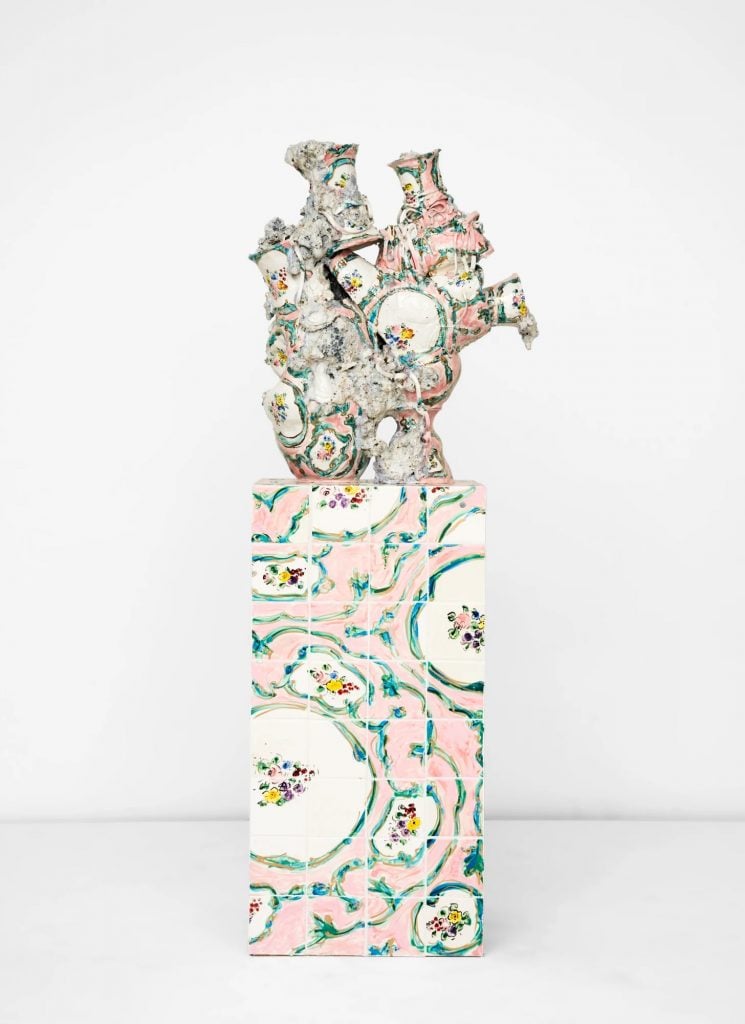
Francesca DiMattio, Sèvres Converse (2023). Courtesy of the artist,
New York artist Francesca Dimattio, too, toys with ideas of fragility, femininity, and consumption. She is best known for her ceramic sculptures that, at first blush, can appear like the finery of Sèvres, which were famously Louis XV’s chief mistress Madame du Pompadour’s preferred porcelain. Another glance reveals the slipperiness of these sculptures, however, which seem to teeter towards collapse in their very forms. “I want to take pieces that we are used to seeing small in a room, objects of service and adornment, and make them primary in a room, loud and powerful.” the artist explained. “I always think of putting things that don’t go together in direct conversation… Through the making, two different worlds get sutured into a new language.”
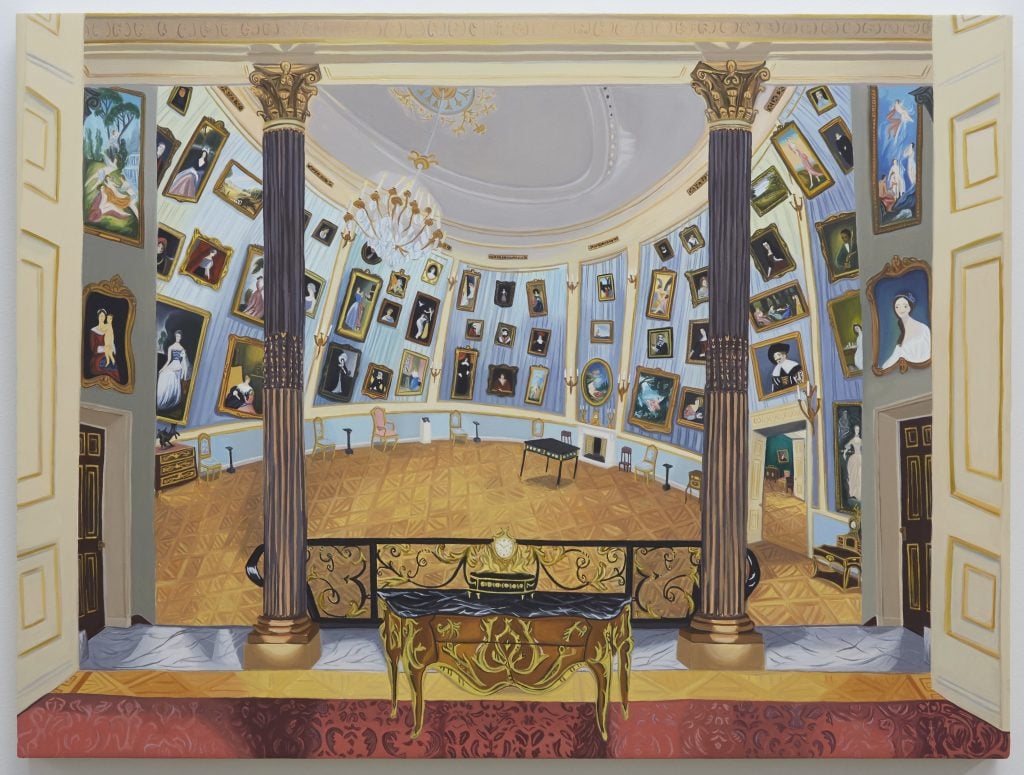
Gretchen Scherer, The Wallace Collection After ‘The Swing’ (2020). Courtesy of Monya Rowe Gallery.
Both von Freyburg and Dimattio capture something of the topsy-turvy, uneven aesthetic that delighted Rococo tastes and hinted, perhaps, at a society careening toward collapse. The vertiginous quality suffused even the architecture of the Rococo world. Artist Gretchen Scherer, who is known for her delightfully idiosyncratic paintings of historic interiors, has painted the interior of the Wallace Collection, the home of many of the most famous Rococo artworks in the world, including Fragonard’s The Swing. In one of her paintings, the museum’s interior seems to be swaying, in motion just like the subject in The Swing. It recalls a ship on the crest of a wave, and is beautiful, if unstable. It captures the hidden complexity of an artistic style focused on beauty and opulence.
“The Rococo style is an upending,” Scherer said. “It’s a very rebellious understanding of space.”





